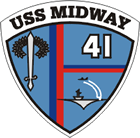USS Midway (CVB 41)
About the Ship's Name, about the Battle of Midway:
A strong Japanese thrust in the central Pacific to occupy Midway Island was led by a four-carrier Mobile Force, supported by heavy units of the Japanese First Fleet, and covered by a diversionary carrier raid on Dutch Harbor in the Aleutian Islands of Alaska. The Japanese attack on Midway was met by a greatly outnumbered U.S. carrier force composed of task Force 17 (Rear Adm. Fletcher) with USS Yorktown (CV 5) and Task Force 16 (Rear Adm. Raymond A. Spruance) with USS Hornet (CV 8) and USS Enterprise (CV 6).
Early in the morning of 4 June, the Japanese sent their torpedo, horizontal and dive bombers against targets on Midway. Hornet, Yorktown, and Enterprise launched strikes as the Japanese carriers struck their planes below to prepare for a second strike on Midway. Hornet's dive bombers missed contact, but 15 planes comprising her Torpedo Squadron 8 found the enemy and pressed home their attacks. They were met by overwhelming fighter opposition about 8 miles from three enemy carriers and followed all the way in to be shot down one by one.
Ens. George H. Gay, USNR, the only surviving pilot, reached the surface as his plane sunk. He hid under a rubber seat cushion to avoid strafing and witness the greatest carrier battle in history. Of 41 torpedo planes launched by the American carriers, only six returned. Their sacrifices drew enemy fighters away from dive bombers of Enterprise and Yorktown which sank three of the four Japanese carriers (Akagi, Kaga, and Soryu) with an assist from submarine USS Nautilus (SS 168). The fourth Japanese carrier, Hiryu, was sunk the following day.
On June 6, 1942, USS Yorktown (CV 5) was attacked by Japanese "Vals" and "Zeros". Intense antiaircraft fire greeted these planes as they approached Yorktown but three "Val" divebombers scored hits, each sending a bomb into the carrier. One bomb blew a 10-sq. ft. hole in the flight deck and started fires. The second pierced the flight deck and exploded in the lower part of the funnel. The third ripped through the number one elevator and exploded on the fourth deck. Within an hour, the crew had the fires sufficiently contained and were refueling aircraft.
The fueling had just begun with the ship's radar picked up more attackers. In minutes, Japanese torpedo planes were attacking. Although the ship was maneuvering radically, two torpedoes tore into her port side and she went dead in the water, listing to port. Without power, the list worsened and all hands were order to abandon ship.
When the ship stubbornly remained afloat, a salvage party was organized to save Yorktown. Power was supplied by USS Hammann (DD 412).
Just as it looked like the Yorktown could be saved, a Japanese submarine fired four torpedoes at the carrier and her assisting destroyer. One torpedo hit Hammann directly amidship and broke her back. She jackknifed and went down rapidly. Two torpedoes hit the carrier, and moments after Hammann's stern slid beneath the waves, her depth charges exploded, killing men in the water and further damaging Yorktown. Although the carrier stayed afloat throughout the night of June 6, men on the ships nearby noted her port list increasing rapidly. At 0701, the valiant flattop rolled over on her port side and sank in 3,000 fathoms of water, her battle flags flying.
Midway was one of the decisive battles of history that had far reaching and enduring results on the Pacific War. Midway was saved as an important base for operations into the western Pacific. Likewise saved was Hawaii. Of greatest importance was the crippling of Japan's carrier strength, a severe blow from which she never fully recovered. The four large aircraft carriers sent to the bottom of the sea carried with them 258 planes along with a high percentage of Japan's most highly trained and battle-experienced carrier pilots. Midway was the turning point of the war in the Pacific.



